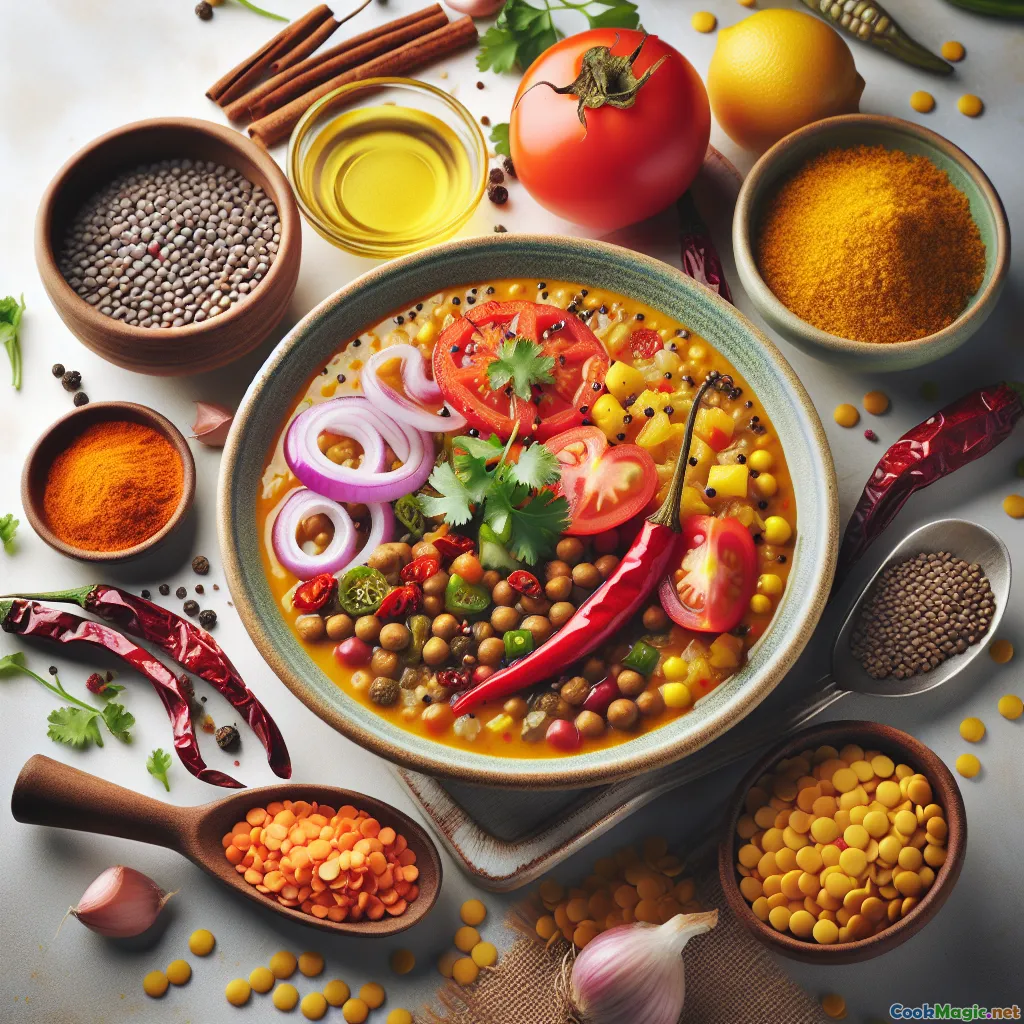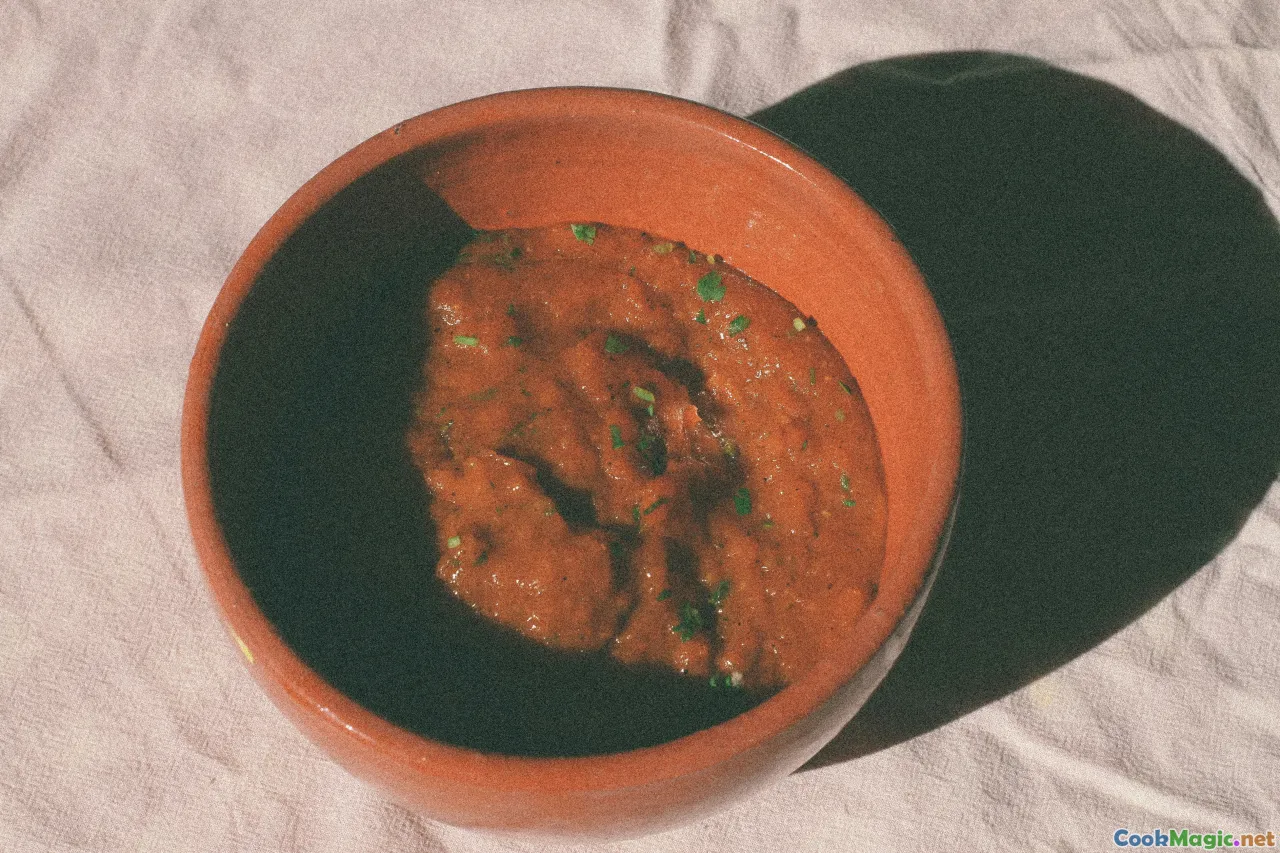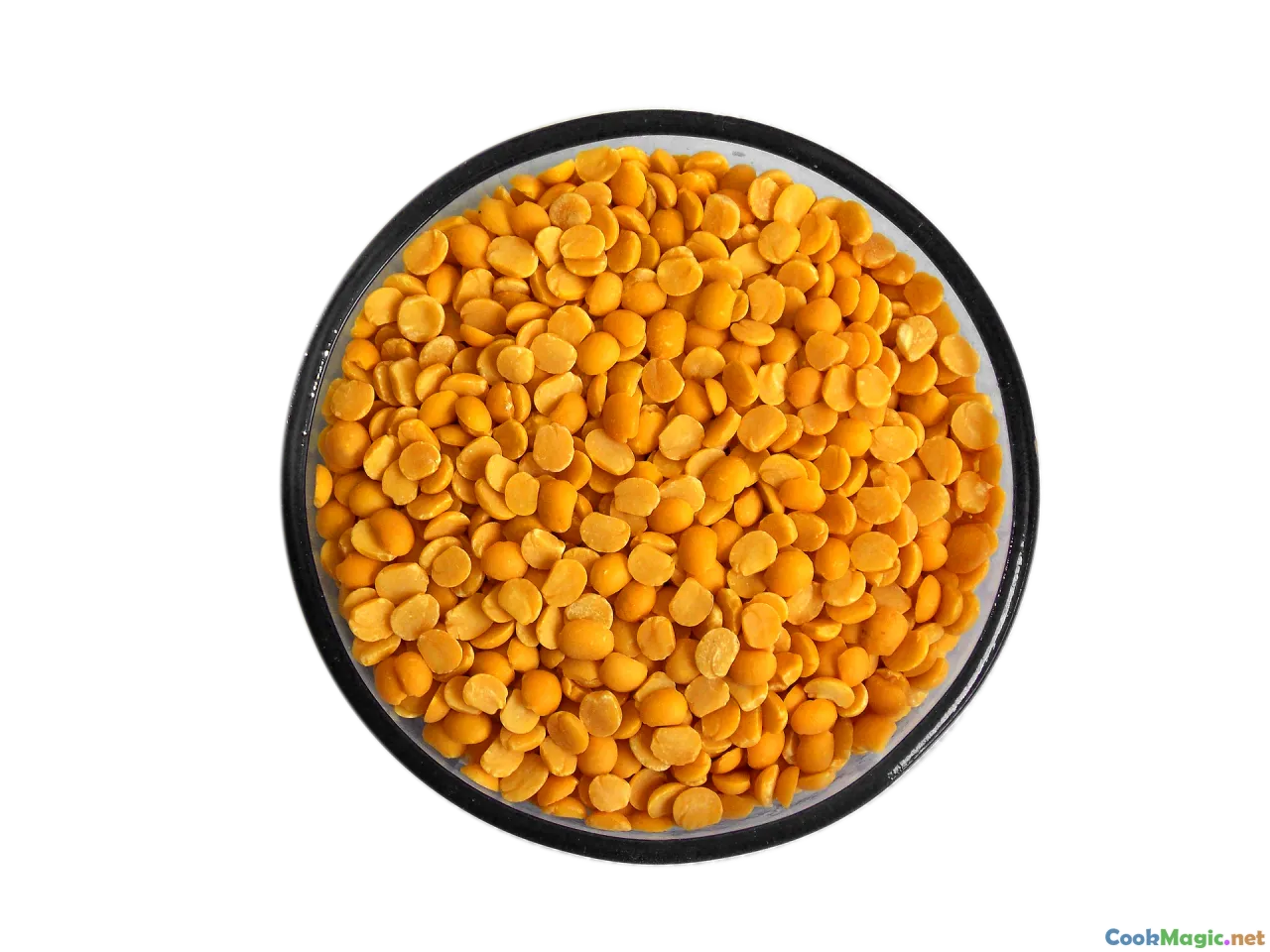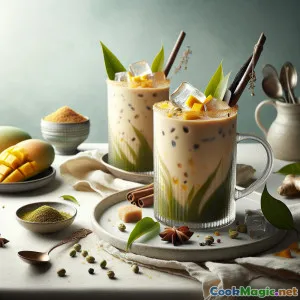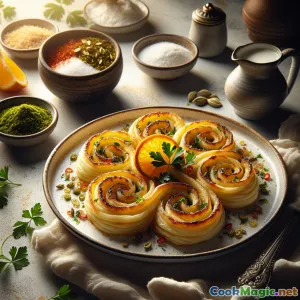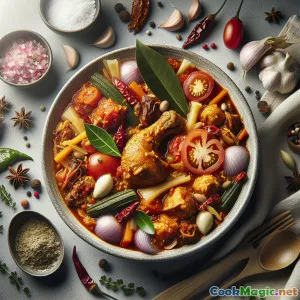
Amber Daal Panchmel Tadka với ghee hun khói
(Amber Daal Panchmel Tadka with Smoky Ghee)
(0 Đánh giá)0
119
tháng 10 24, 2025
Báo cáo sự cố
Nguyên liệu
-
60 grams Đậu Toor (đậu lách tách)
(rinse until water runs clear)
-
50 grams Chana dal (đậu Bengal tách vỡ)
(Adds body and nuttiness)
-
40 grams Masoor dal (đậu lăng đỏ)
(Softens quickly for a silky finish)
-
40 grams Moong dal (đậu xanh vàng đã tách)
(Light flavor; balances richness)
-
30 grams Urad dal (đậu đen Ấn Độ tách vỏ)
(For creamy texture)
-
900 ml Nước
(For pressure cooking the lentils)
-
200 ml Nước nóng
(To adjust consistency after cooking)
-
0.5 tsp Bột Nghệ
(Màu sắc và cảm giác đất đai)
-
100 grams Hành tây, băm nhỏ
(1 small to medium)
-
120 grams Cà chua, xắt nhỏ
(1 medium, ripe)
-
10 grams Gừng, băm nhuyễn
(About 1-inch piece)
-
10 grams Tỏi (băm nhỏ)
(About 3 cloves)
-
1 piece Ớt xanh rạch dọc
(Điều chỉnh theo sở thích về nhiệt độ)
-
2 tbsp Bơ Ghee
(For richness and aroma)
-
1 tbsp Dầu trung tính
(Stabilizes ghee at high heat)
-
1.5 tsp Hạt thì là
(Primary tempering seed)
-
0.5 tsp hạt mù tạt đen
(Optional, adds gentle bite)
-
2 pieces ớt đỏ khô
(Tear for more heat)
-
0.25 tsp Hồi (Hing)
(Aids digestion; classic dal note)
-
10 leaves Lá cà ri
(Tươi ưu tiên)
-
1 tsp Bột ớt Kashmiri đỏ
(Mild heat, vibrant color)
-
1.5 tsp Bột ngò rí
(Citrusy backbone to the masala)
-
1.25 tsp Muối
(Điều chỉnh theo khẩu vị)
-
1 tsp Đường mía chưa tinh luyện (gur), bào nhuyễn
(Balances acidity; optional)
-
2 tsp Nước chanh
(Để tăng độ sáng ở cuối quá trình nấu)
-
2 tbsp Ngò rí tươi (băm nhỏ)
(Để trang trí)
-
1 piece Một mảnh than tự nhiên nhỏ
(For optional dhungar (smoke infusion))
(rinse until water runs clear)
(Adds body and nuttiness)
(Softens quickly for a silky finish)
(Light flavor; balances richness)
(For creamy texture)
(For pressure cooking the lentils)
(To adjust consistency after cooking)
(Màu sắc và cảm giác đất đai)
(1 small to medium)
(1 medium, ripe)
(About 1-inch piece)
(About 3 cloves)
(Điều chỉnh theo sở thích về nhiệt độ)
(For richness and aroma)
(Stabilizes ghee at high heat)
(Primary tempering seed)
(Optional, adds gentle bite)
(Tear for more heat)
(Aids digestion; classic dal note)
(Tươi ưu tiên)
(Mild heat, vibrant color)
(Citrusy backbone to the masala)
(Điều chỉnh theo khẩu vị)
(Balances acidity; optional)
(Để tăng độ sáng ở cuối quá trình nấu)
(Để trang trí)
(For optional dhungar (smoke infusion))
Dinh dưỡng
- Khẩu phần: 4
- Kích thước khẩu phần: 1 bát (300g)
- Calories: 310 kcal
- Carbohydrates: 0 g
- Protein: 14 g
- Fat: 11 g
- Fiber: 12 g
- Sugar: 5 g
- Sodium: 720 mg
- Cholesterol: 18 mg
- Calcium: 120 mg
- Iron: 4.5 mg
Hướng dẫn
-
1 - Rinse and soak the lentils:
Combine all five lentils in a bowl. Rinse under running water, rubbing gently, until water runs almost clear. Soak in warm water for 20 minutes to soften and ensure even cooking (optional but recommended). Drain.
-
2 - Pressure cook the panchmel base:
Add rinsed lentils to a pressure cooker with 900 ml water and turmeric. Cook on medium heat for 5–6 whistles (or 18–20 minutes). Let pressure release naturally. Lentils should be soft and mashable.
-
3 - Whisk to silky consistency:
Open the cooker and whisk or lightly mash the cooked lentils until creamy. If very thick, stir in up to 200 ml hot water to reach a pourable, stew-like consistency.
-
4 - Build the masala base:
In a wide pan, heat 1 tbsp ghee with 1 tbsp oil. Add onion and sauté until translucent and lightly golden. Stir in ginger and garlic; cook until fragrant and no raw smell remains.
-
5 - Spice and soften:
Add coriander powder, Kashmiri chili powder, and green chili. Fry 30 seconds. Add chopped tomato and half the salt; cook until tomatoes are jammy and the fat starts to separate at the edges.
-
6 - Simmer dal with masala:
Pour the whisked lentils into the pan. Stir well, bring to a gentle simmer, and cook 8–10 minutes to marry flavors. Adjust thickness with hot water as needed.
-
7 - Make the finishing tadka:
In a small pan, heat remaining 1 tbsp ghee until shimmering. Add cumin seeds, mustard seeds (optional), dried red chilies, and curry leaves. When they crackle, switch off heat and add asafoetida. Immediately pour over the simmering dal. Stir in jaggery if using and the remaining salt to taste.
-
8 - Optional dhungar (smoke infusion):
If smoking, heat a small charcoal piece until red-hot. Nestle it in a steel bowl set atop the dal, drizzle a few drops of ghee on the coal to produce smoke, cover the pot, and infuse for 2 minutes. Remove coal and bowl.
-
9 - Brighten and garnish:
Stir in lemon juice for brightness. Sprinkle chopped cilantro and gently fold through.
-
10 - Serve Warm:
Serve the amber-hued dal hot with steamed basmati rice, jeera rice, bajra roti, phulka, or naan. Let rest 2–3 minutes for the tadka aroma to settle.
Combine all five lentils in a bowl. Rinse under running water, rubbing gently, until water runs almost clear. Soak in warm water for 20 minutes to soften and ensure even cooking (optional but recommended). Drain.
Add rinsed lentils to a pressure cooker with 900 ml water and turmeric. Cook on medium heat for 5–6 whistles (or 18–20 minutes). Let pressure release naturally. Lentils should be soft and mashable.
Open the cooker and whisk or lightly mash the cooked lentils until creamy. If very thick, stir in up to 200 ml hot water to reach a pourable, stew-like consistency.
In a wide pan, heat 1 tbsp ghee with 1 tbsp oil. Add onion and sauté until translucent and lightly golden. Stir in ginger and garlic; cook until fragrant and no raw smell remains.
Add coriander powder, Kashmiri chili powder, and green chili. Fry 30 seconds. Add chopped tomato and half the salt; cook until tomatoes are jammy and the fat starts to separate at the edges.
Pour the whisked lentils into the pan. Stir well, bring to a gentle simmer, and cook 8–10 minutes to marry flavors. Adjust thickness with hot water as needed.
In a small pan, heat remaining 1 tbsp ghee until shimmering. Add cumin seeds, mustard seeds (optional), dried red chilies, and curry leaves. When they crackle, switch off heat and add asafoetida. Immediately pour over the simmering dal. Stir in jaggery if using and the remaining salt to taste.
If smoking, heat a small charcoal piece until red-hot. Nestle it in a steel bowl set atop the dal, drizzle a few drops of ghee on the coal to produce smoke, cover the pot, and infuse for 2 minutes. Remove coal and bowl.
Stir in lemon juice for brightness. Sprinkle chopped cilantro and gently fold through.
Serve the amber-hued dal hot with steamed basmati rice, jeera rice, bajra roti, phulka, or naan. Let rest 2–3 minutes for the tadka aroma to settle.
Thông tin thêm về: Amber Daal Panchmel Tadka với ghee hun khói
What is Amber Daal Panchmel Tadka?
Amber Daal Panchmel Tadka is a vibrant, five-lentil stew inspired by Rajasthani panchmel dal and finished with a perfumed ghee tempering. The word “panchmel” refers to the five-lentil medley—each dal contributes distinct texture and character. Together, they create a balanced bowl that’s creamy, nutty, gently sweet, and beautifully spiced. The final tadka—ghee sizzling with cumin, mustard, dried chilies, curry leaves, and asafoetida—lands like a flourish, releasing a cloud of aromatics that perfume the entire dish. An optional dhungar (charcoal smoke) turns the whole pot into a campfire-kissed comfort food.
Why this version is special
- Balanced blend: Toor and chana lend body; masoor and moong melt into silk; a little urad gives creamy heft. The result is spoon-coating but not heavy.
- Amber tone: Kashmiri chili and turmeric bring a burnished amber hue without harsh heat—eye-catching and approachable.
- Layered tadka: A two-stage flavoring—first simmering the dal with a tomato-onion masala, then a sizzling ghee temper—creates depth and a restaurant-level finish.
- Optional smoke: A brief dhungar adds complexity reminiscent of tandoor-fired breads and clay pot cooking.
Serving suggestions
- Classic: Serve with steamed basmati or jeera rice for a complete, comforting meal.
- Roti route: Pair with bajra roti or phulka to echo Rajasthani traditions.
- Feast mode: Add cucumber-onion salad, papad, achar, and a dollop of yogurt to round out textures and temperatures.
- Leftover magic: Reduce on the stove until thicker and use as a spread in a naan wrap with crunchy onions and herbs.
Tips & notes
- Dal prep: A quick 20-minute soak shortens cooking and leads to more even softening across different pulses.
- Consistency control: Panchmel dal should be creamy yet pourable. Whisk well after cooking and add hot water to loosen if needed.
- Tadka timing: Tempering spices should bloom but not burn. If the oil smokes aggressively, pull the pan off heat for a few seconds before adding delicate spices like hing.
- Heat balance: Use Kashmiri chili for color and mild warmth; add fresh green chili or a pinch of regular chili powder if you prefer more heat.
- Sweetness cue: A teaspoon of jaggery won’t make the dal sweet—it merely rounds acidity and bitter edges, especially if your tomatoes are sharp.
- Smoke safely: For dhungar, always use natural charcoal, heat it safely with tongs, and keep a lid ready. Two minutes is plenty—over-smoking can overwhelm the lentils.
- Vegan swap: Replace ghee with coconut oil or neutral oil. You’ll lose the buttery aroma, but the spice profile still shines.
- Gluten note: Asafoetida can be cut with wheat flour in some brands. Seek a gluten-free hing if required.
Cultural roots
Panchmel (or panchratna) dal has roots across Rajasthan and parts of Marwar, where scarcity and ingenuity shaped cuisine. Combining multiple pulses ensured a complete protein profile, better texture, and a comforting richness without extravagant ingredients. It’s a dish that bridges everyday sustenance and celebratory spreads—humble enough for a weekday, dignified enough for a thali at a wedding. The playful finishing tadka is the cook’s signature: the same base dal can taste remarkably different from one household to the next, depending on the tempering seeds, the fat used, or the final sour note (lemon, kokum, or amchur).
Technique highlights
- Pressure cooking: Speeds up prep and ensures each dal cooks through without turning grainy. Natural pressure release protects the lentils from bursting.
- Two-stage flavoring: First, the masala is cooked until jammy to remove raw notes; then the tadka is bloomed separately to protect volatile aromas and deliver a dramatic tableside pour.
- Textural engineering: Mashing part of the dal while leaving a little bite from chana dal creates a layered mouthfeel—silky base with subtle nubs.
Ingredient swaps
- Lentils: If you’re missing one dal, increase another in equal measure. Keep the total weight similar for balance.
- Fat: Ghee is traditional; butter gives similar richness; avocado or mustard oil provide distinct regional twists.
- Sourness: Lemon is bright; try amchur (dried mango) for mellow tartness or tamarind for a tangy-sweet depth.
- Herbs: Cilantro is classic; fresh kasuri methi (fenugreek leaves) adds a sweet, maple-like perfume when used sparingly.
Make-ahead & storage
- Batch cook: Cook the dal base and refrigerate for up to 4 days or freeze for 2 months. Add the tadka fresh when reheating for best aroma.
- Reheat gently: If thick after chilling, loosen with hot water and re-season. A quick mini-tadka on reheating restores the just-cooked magic.
Personal note
This “Amber” rendition aims for warmth and harmony rather than fire. The color signals comfort; the aroma promises home. Every time the tadka shatters the quiet—seeds crackling, curry leaves snapping—it feels like a celebration of small rituals. Ladled over rice, it’s the kind of bowl that invites a slower pace, one fragrant spoon at a time.
